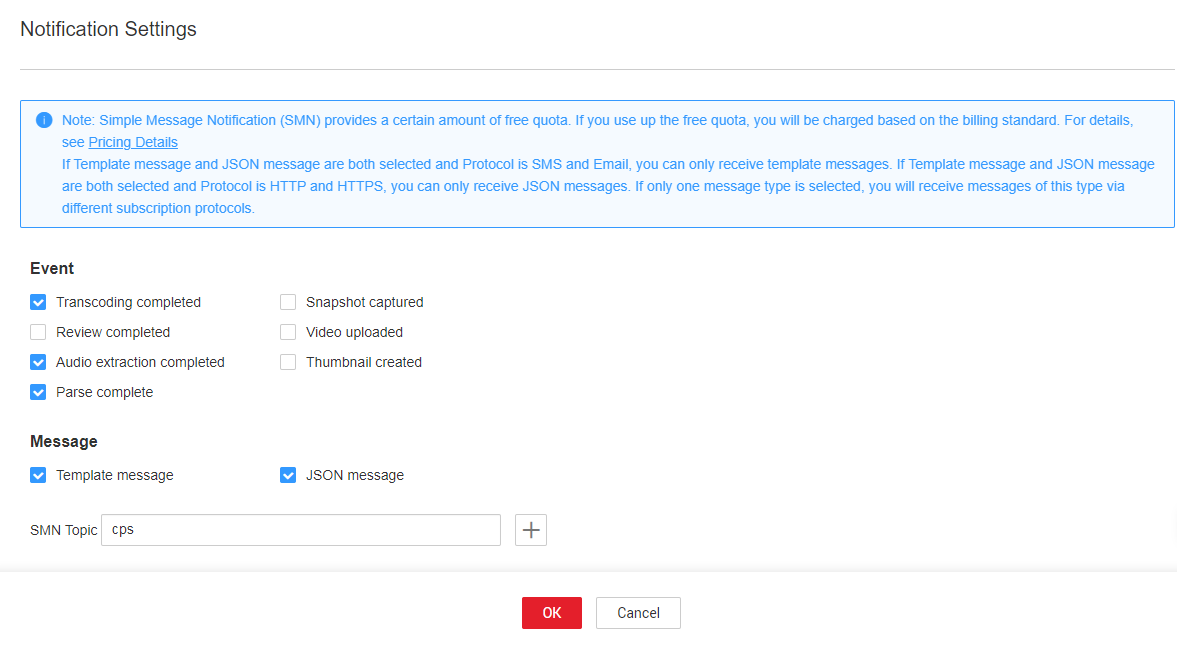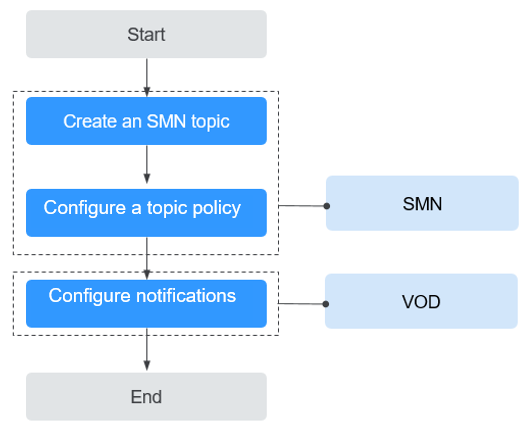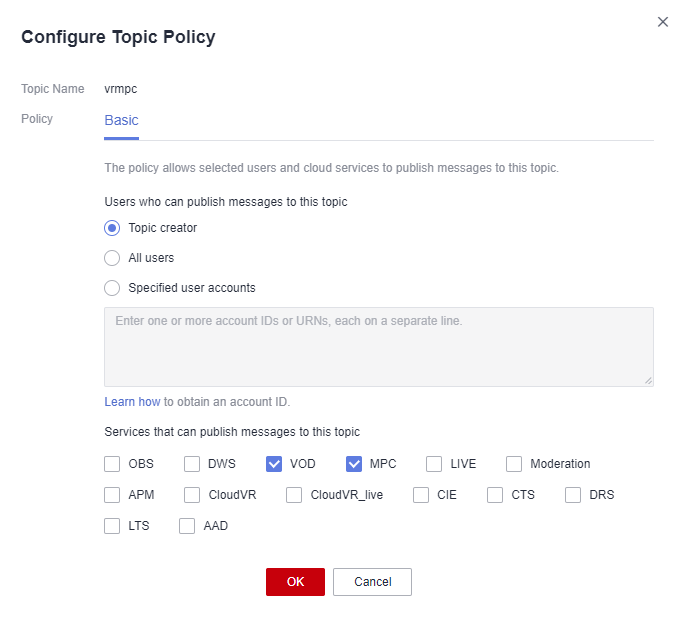SMN
SMN charges messages separately. For details, see SMN Pricing Details.
Functions
- A topic is a specified event for message publishing or subscription notification. It serves as a message sending channel, where publishers and subscribers can interact with each other. Before configuring notifications, you must create a topic.
- VOD notification types include Transcoding completed, Snapshot captured, Review completed, Video uploaded, Audio extraction completed, and Thumbnail created. Subscription is to associate a subscriber to a topic. A user can have multiple topics, and each topic has multiple subscribers.
Process Flow
Figure 1 shows the process of configuring notifications.
- Create an SMN Topic on the SMN console.
- Configure a topic policy to authorize VOD to publish messages to the topic.
- Configure notifications on the VOD console so that you can receive notifications during operations such as transcoding, snapshot capturing, and review.
Creating an SMN Topic
- Log in to the SMN console.
- In the navigation pane on the left, choose Topic Management > Topics.
- Click Create Topic in the upper right corner.
The Create Topic dialog box is displayed. Table 1 describes the required parameters.
Table 1 Topic parameters Parameter
Description
Topic Name
Specifies the topic name, which
- Contains only letters, digits, hyphens (-), and underscores (_), and must start with a letter or digit.
- Contains 1 to 255 characters.
- Must be unique and cannot be modified after the topic is created.
Display Name
This parameter is optional. When sending an email:
- If the display name is not specified, the sender is displayed as username@example.com.
- If the display name is specified, the email sender is presented as Display name<username@example.com>.
Enterprise Project
Centrally manages cloud resources and members by project.
Tag
Specifies a key-value pair. Tags identify cloud resources so that you can easily categorize and search for your resources.
- Click OK.
- Click Add Subscription in the Operation column of the new topic. The Add Subscription dialog box is displayed.
Configure the subscription protocol and endpoints. See Figure 2.
Table 2 describes the subscription parameters.
Table 2 Subscription parameters Parameter
Description
Topic Name
Name of the topic to be subscribed to. Retain the default value.
Protocol
Message notification method. Select a protocol from the drop-down list.
The common protocols used by MPC are SMS, Email, HTTP, and HTTPS.
Endpoint
Specifies the IP address of a subscription endpoint. You can enter up to 10 SMS, email, HTTP, or HTTPS endpoints, one in each line.
- SMS: Enter one or more valid phone numbers.
The format is + country code phone number, for example, +8600000000000.
Subscribers will receive a subscription confirmation message valid for 48 hours and must confirm the subscription to receive messages published to the topic.
- Email: Enter one or more valid email addresses, for example, username@example.com.
Subscribers will receive a subscription confirmation email valid for 48 hours and must confirm the subscription to receive messages published to the topic.
- If you select HTTP or HTTPS, enter a public network address and confirm the subscription, for example, https://example.com/notification/action.
HTTPS is recommended, as it is more secure than HTTP.
- SMS: Enter one or more valid phone numbers.
- Click OK to add a subscription. You can view the subscription on Topic Management > Subscriptions.
After the subscription is added, the configured subscription endpoint will receive a subscription confirmation message. The subscription confirmation link is valid for 48 hours. You need to confirm the subscription within the validity period so that you can receive messages published to the topic.
Configuring a Topic Policy
- In the navigation pane of the SMN console, choose Topic Management > Topics.
- Click More > Configure Topic Policy in the Operation column.
- Configure topic policy parameters by referring to Figure 3.
Topic policies are classified into basic mode and advanced mode. The basic mode simply specifies which users or cloud services have permissions to publish messages to a topic. See Figure 3.
Table 3 Description for configuring a topic policy in basic mode Item
Settings
Description
Users who can publish messages to this topic
Topic creator
Only the topic creator has permission to publish messages to the topic.
All users
All users have permission to publish messages to the topic.
Specified user accounts
Only specified users have permission to publish messages to the topic.
Users are specified in the format urn:csp:iam::domainId:root,
in which domainId indicates the account ID of a user. Every two users are separated with a comma (,). SMN does not limit the number of users you can specify, but the total length of a topic policy cannot exceed 30 KB.NOTE:- Enter the account ID of the user and click OK. Other information is automatically supplemented by the system.
- To obtain a user's account ID, log in to the SMN console, hover the mouse over the username in the upper right corner and choose My Credentials from the drop-down list.
Services that can publish messages to this topic
See Figure 3.
Select VOD. VOD has the permissions to access the topic.
Configuring Notifications
- Log in to the VOD console.
- In the navigation pane, choose Global Settings > Notification Settings.
Figure 4 Configuring notifications

- Select one or more events.

If you select both Snapshot captured and Thumbnail created, only Snapshot captured will trigger notifications.
- Select one or more message types.

If Template message and JSON message are both selected, you will receive template messages via SMS and email, and receive JSON messages via HTTP and HTTPS.
- Select Template message. Table 2 describes what a template message looks like. The variables in the notification text message are subject to the actual operation.
Table 4 Template message Event
Status
Message Body
Transcoding completed
Completed
Dear user, your video transcoding task has been completed. Video ID: {asset_id}; name: {title}. Log in to the VOD console or call a VOD API to view transcoding details.
Failed
Dear user, an error occurred when transcoding your video. Video ID: {asset_id}; name: {title}; error code: {err_code}; error information: {err_msg}.
Snapshot captured
Completed
Dear user, your snapshot task has been completed. Video ID: {asset_id}; name: {title}. Log in to the VOD console or call a VOD API to view snapshot details.
Failed
Dear user, an error occurred when processing your snapshot task. Video ID: {asset_id}; name: {title}; error code: {err_code}; error information: {err_msg}.
Review completed
Completed
Dear user, your review task has been completed. Video ID: {asset_id}; name: {title}; review advice: {suggestion}. Log in to the VOD console or call a VOD API to view review details.
Failed
Dear user, an error occurred when reviewing your video. Video ID: {asset_id}; name: {title}; error code: {err_code}; error information: {err_msg}.
Video uploaded
Completed
Dear user, your video has been uploaded. Video ID: {asset_id}; name: {title}. Log in to the VOD console or call a VOD API to view video details.
Failed
Dear user, an error occurred when uploading your video. Video ID: {asset_id}; name: {title}; error code: {err_code}; error information: {err_msg}.
Audio extraction completed
Completed
Dear user, your audio extraction task has been completed. Audio ID: {asset_id}; name: {title}. Log in to the VOD console or call a VOD API to view audio details.
Failed
Dear user, an error occurred when processing your audio extraction task. Audio ID: {asset_id}; name: {title}; error code: {err_code}; error information: {err_msg}.
Thumbnail created
Completed
Dear user, your video thumbnail has been created. Video ID: {asset_id}; name: {title}. Log in to the VOD console or call a VOD API to view video details.
Failed
Dear user, your video thumbnail fails to be created. Video ID: {asset_id}; name: {title}; error code: {err_code}; error information: {err_msg}.
Parse complete
Completed
Dear user, your video has been parsed. Video ID: {asset_id}; name: {title}. Log in to the VOD console or call a VOD API to view video details.
Failed
Dear user, an error occurred when parsing your video. Video ID: {asset_id}; name: {title}; error code: {err_code}; error information: {err_msg}.
- Select JSON message. Table 3 describes what a template message looks like.
Table 5 JSON message Parameter
Description
Type
event_type
Event type. The options are as follows:
- transcodeComplete: transcoding (encryption) completed
- thumbnailComplete: snapshot captured
- reviewComplete: review completed
- createComplete: media file created
- audioExtractComplete: audio extracted
- coverComplete: thumbnail created
- parseComplete: media file parsed
String
transcode_info
Transcoding (including encryption) message. For details, see Transcoding Message Body.
TranscodeInfo
thumbnail_info
Snapshot message. For details, see Snapshot Message Body.
ThumbnailInfo
review_info
Review message. For details, see Review Message Body.
ReviewInfo
create_info
Media file upload message. For details, see Media Upload and Audio Extraction Message Body.
AssetInfo
audio_extract_info
Audio extraction message. For details, see Media Upload and Audio Extraction Message Body.
AssetInfo
cover_info
Thumbnail message. For details, see Thumbnail Message Body.
CoverInfo
parse_info
Media file parsing completion message. This parameter is available only when a media file has been parsed. For details, see Media Asset Parsing Message Body.
ParseInfo
- Select Template message. Table 2 describes what a template message looks like. The variables in the notification text message are subject to the actual operation.
- Select an SMN topic.
- Click OK.
Feedback
Was this page helpful?
Provide feedbackThank you very much for your feedback. We will continue working to improve the documentation.See the reply and handling status in My Cloud VOC.
For any further questions, feel free to contact us through the chatbot.
Chatbot








